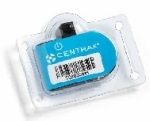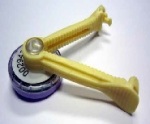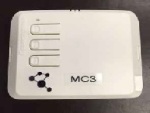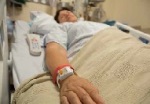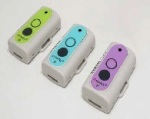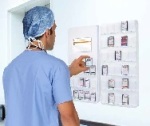RTLS market for health care to exceed $3 billion by 2022
February 28, 2017
by Lisa Chamoff, Contributing Reporter
Health care facilities are increasingly using real-time location systems (RTLS) to track the location of patients and valuable equipment, as well as safety initiatives such as hand hygiene compliance. A report published last year by MarketsandMarkets predicted that the RTLS market for health care is expected to grow to $3.12 billion by 2022, at a compound annual growth rate of nearly 24 percent. Several companies offer RTLS, in which battery-operated tags provide constant location information, while some offer active and passive radio frequency identification (RFID), which provides location data at fixed points. Others provide the software, and also bridge the divide between data and analytics, part of a trend toward using the data to help hospitals improve workflow and outcomes.
The following is a guide to help you take stock of what several companies provide and what’s new or on the horizon.
CenTrak
CenTrak, which has health care clients around the world, supports a wide range of health care applications through its Enterprise Location Services offering, including asset tracking and management, staff locating and safety, environmental monitoring, patient location and hand hygiene compliance. Recent developments for CenTrak’s Enterprise Location Services platform include both single-use and 31-day versions of the company’s RFID tags. The tags, housed in smooth pouches that can be easily sanitized, are color-coded by month and can be reused over 31 days. This makes the tags less expensive per use, says Will Lukens, CenTrak’s chief commercial officer. The company has also responded to the adoption of Bluetooth technology in smart-phones and mobile devices and, in 2015, added Bluetooth Low Energy (BLE) to its RTLS platform — which already utilizes second-generation infrared and Wi-Fi — allowing a connection between CenTrak’s RTLS system and other devices.
Guard RFID
GuardRFID offers an active RFID technology platform for health care applications that includes its Asset Tracking & Location Solution, a patient flow management system called AllGuard, infant and pediatric security called TotGuard and wandering patient and staff duress with its SafeGuard solutions. The systems have evolved over the years based on customer demand, says Doug Stevens, the company’s vice president of sales and marketing. “We started with just a few different tag types for infant and assets and now we provide over a dozen tags for various applications,” Stevens says. The company has also developed an HL7 integration based on the Integrating the Healthcare Enterprise (IHE) initiative, which allows it to send location information to patient care devices and to electronic medical records (EMR) software. It will be demonstrated at the HIMSS Interoperability Showcase exhibit.
Intelligent InSites
On the software side, Intelligent InSites takes the data generated by RTLS systems to populate dashboards to help staff make decisions. The company’s Soiled PAR Dashboard, for example, lets equipment owners know the amount of ready-to-clean equipment in soiled utility rooms in real time, which helps them prioritize their time when picking up equipment to bring to the sterile processing department for cleaning, says Alex Hoffman, a product manager for Intelligent InSites. One of the company’s specialties is providing software and services for medical and urgent care clinics. A popular tool customers use is the Patient Cycle Time Report, which shows how much time patients are spending in each milestone of their appointment, which can be used to decrease wait times.
“Some of our customers have completely eliminated patient waiting through self-rooming,” Hoffman says. “Patients go straight to the exam room and the care team can see at a glance when they have arrived.” In 2015, the company responded to the trend toward mobility and launched smart-phone and tablet applications. InSites Locate shows the real-time location of equipment and staff on a device, and allows staff to receive alerts and messages from the system and their coworkers. “It’s big for boosting staff communication, which also improves the patient experience,” Hoffman says.
Mesh Candy
Mesh Candy, a startup that has been incubating within medical device manufacturer and repair company Tenacore, is a newcomer, installing its asset locating, environmental data gathering and hand hygiene compliance technology in a few surgery centers and hospitals starting in 2015. Brand Caso, the cofounder and chief operating officer of Tenacore, says the Mesh Candy solution doesn’t require as much of a build-out as traditional RTLS systems. “We can work with a single android tablet and form our network around the tablet,” Caso says. “A phlebotomist can have it in their car.” In 2017, the company will focus on further refining its environmental data gathering product and later in the year will introduce asset tracking.
STANLEY Healthcare
STANLEY Healthcare provides a full suite of RTLS solutions, including asset management, environmental monitoring, staff and patient security, patient flow, infant protection and hand hygiene compliance monitoring. Joel Cook, senior director of healthcare solutions for STANLEY Healthcare, has noticed a major trend in the last few years for solutions to migrate to Wi-Fi. There has also been a major push toward RTLS companies providing patient flow solutions and using that data to improve workflow and decrease wait times. The company’s By Your Side customer care program, launched at the end of 2016, aims to help clients use the RTLS data to improve processes. STANLEY has been working with a large cancer center in the Southwest to help the facility use RTLS data for prescriptive scheduling models, strategizing when to schedule easier and more difficult cases to cut down on wait times and improve throughput. “As people have gone through their first and second wave of EMR deployment, they have asked, ‘How do I better use the information I can glean from the EMR,’” Cook says.
Sonitor Technologies
Sonitor Technologies differs from its competitors by using ultrasound as the core technology for its RTLS system, as opposed to traditional technologies such as infrared, resulting in more accurate positioning, says Sandra Rasmussen, Sonitor’s vice president of marketing. “The technology creates virtual walls that create frames within an open space. For example, if you’re in a room and you want to be able to divide that room into two or more bays,” Rasmussen says. The company’s new SenseVIEW software platform, launched in 2016, provides local and remote system monitoring, showing the performance and health of the system. It provides information on battery status, Rasmussen says, and the company can also perform remote diagnostics and remote configuration. The company has other products in development. “We expect there’s a lot more innovation left in ultrasound technology,” Rasmussen says.
Skytron
Skytron, which specializes in OR equipment, also offers an active RTLS solution for asset, staff and patient management and for temperature and environmental monitoring, as well as passive RFID technology for supply chain management and procedural documentation. The company’s newest products include the recently released iRIScope, a passive RFID solution to document the use cycle of flexible endoscopes, including storage, use and the processing and cleaning process, and to provide reporting and analytics. “The main purpose of that solution is promoting regulatory compliance and patient safety,” says Jennifer Daniel, assistant product manager for process solutions at Skytron. “The biggest competitor is written or manual documentation, which is subject to human error.”
The company is set to launch Advantages OR, an OR workflow using active RTLS. The product uses active RTLS to track patients and caregivers throughout the preoperative, operative and postoperative process, with the goal of cutting wait times and making sure certain checklist items are completed. Skytron’s business model is unique in that it is partnering with other companies that will provide the hardware and software — for iRIScope, Skytron is partnering with Mobile Aspects while for Advantages OR, it is partnering with Versus Technology — and will serve as a major sales channel for both products. “Our solution mix can sometimes be a variation of business models,” Daniel says. “They all grow around our strengths in the OR.”
TECSYS
TECSYS’ 2014 acquisition of Logi-D allowed the company to expand its offerings to include RFID technology that automates management and replenishment of medical supplies. The latest development for the company is its next generation Smart-panel, a touch-screen that provides real-time information on inventory levels and replenishment status. Released a year ago, the smart-panel is available on the company’s two-bin system for general supply items and its smart-bin product for high-value items. “Adding a dynamic user interface to the smart-panel has uniquely enhanced the clinical experience within a two-bin environment,” says Jean-Philippe Racette, product marketing manager for point-of-use solutions at TECSYS. “The up-to-date information provides more efficient interaction between the clinical and supply chain teams and improves replenishment cycles.”
Terso Solutions
Terso Solutions works with both manufacturers and health care facilities, and its RFID sensors are used from the time a product, such as an implant, is manufactured to when it is used in the operating room, interventional suite or another department. Hospitals use the company’s RAIN RFID enclosures, such as cabinets, refrigerators and freezers, that keep track of inventory and forward data to Terso’s Jetstream cloud-based software. Jason Rosemurgy, vice president of sales and marketing for Terso, says that as not all high-value inventory can fit in a cabinet, the company has expanded to “smart” room-based solutions.
On the mobile side, Terso has also begun providing more transportable services, most recently piloting trackable loaner kits for use by medical device companies, such as orthopedic implant company Medacta USA. The RFID-enabled case, equipped with an RFID reader, provides daily updates on the stock of implants within the case, which are used by hospitals and outpatient facilities, and where the case is located. This is specifically important to managing in-field inventory. The company is planning to continue to develop and offer more mobile products, Rosemurgy says.
TeleTracking Technologies
TeleTracking is a software company that utilizes data from RTLS vendors to track the location of patients, staff and assets, as well as hand hygiene compliance. The RTLS technology also integrates with TeleTracking’s patient flow software. The company works with other big players in the RTLS space, including Sonitor, Centrak and STANLEY Healthcare. When making a decision on the locating technology, a facility can buy everything from TeleTracking. “We look to be a data broker for our clients, and help them make educated decisions around the enabling technology that will meet their use case and workflow requirements,” says Jon Poshywak, vice president and general manager of RTLS at TeleTracking. Effectively managing patient discharges is a big challenge for facilities. Poshywak says he has seen many cases at facilities where patients have left the hospital, but the caregiver is still finishing documentation in the patient’s electronic medical record, so rooms that are ready to fill sit empty, which is sometimes referred to as “dead bed time.” “Once a patient hits a discharge location, the system sends an alert that the room is ready to be cleaned,” Poshywak says. “It’s really driving data-to-service teams to be effective.”
Versus Technology
Versus Technology provides RTLS solutions for patient flow, asset management and safety. In the last several years, the company has been pushing into the outpatient setting and also helping its clients use the information to create better workflows. Versus clients have been using the company’s Advantages Clinic patient flow system for what it calls “self rooming,” says Charles Springsteen, a product manager at Versus Technology. To use the system, the patient clips a locating badge on their shirt and proceeds to the assigned exam room. When the patient has arrived in the exam room, the system sends notifications to staff that the patient is ready to be seen. One client using the platform, Virginia Mason Hospital & Medical Center in Seattle, used much of its unused waiting area to build new exam rooms, Springsteen says. New last year, Versus — which was acquired by Midmark Corporation in May 2016 — is providing consulting services through its Performance Improvement Consulting division. The division can help facilities redesign workflows based on LEAN/Six Sigma management practices. “We’re going beyond software,” Springsteen says.
VIZZIA Technologies
VIZZIA Technologies serves as a bridge between the hospital and RTLS/RFID providers by consulting with facilities to make sure they purchase the appropriate products, and helping them deploy and manage the systems, with the goal of building the proper internal processes to achieve a return on investment, says Andrew Halasz, the company’s president and chief executive officer. “It’s all about getting the value out of the technologies deployed,” Halasz says. A hospital can hire VIZZIA to use the data from the RTLS/RFIDsystems to reduce the need for rental equipment and improve the availability of equipment for nurses, so they don’t have to waste time searching for and cleaning equipment. The company recently added an environmental monitoring help desk. Halasz says the product eliminates the need for hospital staff to enter the root-cause/corrective actions taken when alerts are triggered by sensors that indicate the temperature of a refrigerator or freezer has gone out of range. “This eliminates the need for staff to learn new software and how to navigate to the right screens in order to comply with this important regulatory requirement,” Halasz says.
Zebra Technologies
Zebra Technologies provides RTLS hardware solutions for a number of industries, including health care, with 30 health care RTLS applications that employ a variety of technologies, including Wi-Fi, BLE and GPS. Looking to the future, Zebra is harnessing a growing trend of using data to promote change in an automated way. The company has in the pipeline some proprietary software with algorithms that provide a “smoothing of the data,” says Chris Sullivan, Zebra’s Global Healthcare practice lead. “We’re going towards taking data and bringing operational intelligence and pattern recognition,” Sullivan says. Zebra will have customers live with a middleware system in mid-2017.
The following is a guide to help you take stock of what several companies provide and what’s new or on the horizon.
CenTrak
CenTrak, which has health care clients around the world, supports a wide range of health care applications through its Enterprise Location Services offering, including asset tracking and management, staff locating and safety, environmental monitoring, patient location and hand hygiene compliance. Recent developments for CenTrak’s Enterprise Location Services platform include both single-use and 31-day versions of the company’s RFID tags. The tags, housed in smooth pouches that can be easily sanitized, are color-coded by month and can be reused over 31 days. This makes the tags less expensive per use, says Will Lukens, CenTrak’s chief commercial officer. The company has also responded to the adoption of Bluetooth technology in smart-phones and mobile devices and, in 2015, added Bluetooth Low Energy (BLE) to its RTLS platform — which already utilizes second-generation infrared and Wi-Fi — allowing a connection between CenTrak’s RTLS system and other devices.
Guard RFID
GuardRFID offers an active RFID technology platform for health care applications that includes its Asset Tracking & Location Solution, a patient flow management system called AllGuard, infant and pediatric security called TotGuard and wandering patient and staff duress with its SafeGuard solutions. The systems have evolved over the years based on customer demand, says Doug Stevens, the company’s vice president of sales and marketing. “We started with just a few different tag types for infant and assets and now we provide over a dozen tags for various applications,” Stevens says. The company has also developed an HL7 integration based on the Integrating the Healthcare Enterprise (IHE) initiative, which allows it to send location information to patient care devices and to electronic medical records (EMR) software. It will be demonstrated at the HIMSS Interoperability Showcase exhibit.
Intelligent InSites
On the software side, Intelligent InSites takes the data generated by RTLS systems to populate dashboards to help staff make decisions. The company’s Soiled PAR Dashboard, for example, lets equipment owners know the amount of ready-to-clean equipment in soiled utility rooms in real time, which helps them prioritize their time when picking up equipment to bring to the sterile processing department for cleaning, says Alex Hoffman, a product manager for Intelligent InSites. One of the company’s specialties is providing software and services for medical and urgent care clinics. A popular tool customers use is the Patient Cycle Time Report, which shows how much time patients are spending in each milestone of their appointment, which can be used to decrease wait times.
“Some of our customers have completely eliminated patient waiting through self-rooming,” Hoffman says. “Patients go straight to the exam room and the care team can see at a glance when they have arrived.” In 2015, the company responded to the trend toward mobility and launched smart-phone and tablet applications. InSites Locate shows the real-time location of equipment and staff on a device, and allows staff to receive alerts and messages from the system and their coworkers. “It’s big for boosting staff communication, which also improves the patient experience,” Hoffman says.
Mesh Candy
Mesh Candy, a startup that has been incubating within medical device manufacturer and repair company Tenacore, is a newcomer, installing its asset locating, environmental data gathering and hand hygiene compliance technology in a few surgery centers and hospitals starting in 2015. Brand Caso, the cofounder and chief operating officer of Tenacore, says the Mesh Candy solution doesn’t require as much of a build-out as traditional RTLS systems. “We can work with a single android tablet and form our network around the tablet,” Caso says. “A phlebotomist can have it in their car.” In 2017, the company will focus on further refining its environmental data gathering product and later in the year will introduce asset tracking.
STANLEY Healthcare
STANLEY Healthcare provides a full suite of RTLS solutions, including asset management, environmental monitoring, staff and patient security, patient flow, infant protection and hand hygiene compliance monitoring. Joel Cook, senior director of healthcare solutions for STANLEY Healthcare, has noticed a major trend in the last few years for solutions to migrate to Wi-Fi. There has also been a major push toward RTLS companies providing patient flow solutions and using that data to improve workflow and decrease wait times. The company’s By Your Side customer care program, launched at the end of 2016, aims to help clients use the RTLS data to improve processes. STANLEY has been working with a large cancer center in the Southwest to help the facility use RTLS data for prescriptive scheduling models, strategizing when to schedule easier and more difficult cases to cut down on wait times and improve throughput. “As people have gone through their first and second wave of EMR deployment, they have asked, ‘How do I better use the information I can glean from the EMR,’” Cook says.
Sonitor Technologies
Sonitor Technologies differs from its competitors by using ultrasound as the core technology for its RTLS system, as opposed to traditional technologies such as infrared, resulting in more accurate positioning, says Sandra Rasmussen, Sonitor’s vice president of marketing. “The technology creates virtual walls that create frames within an open space. For example, if you’re in a room and you want to be able to divide that room into two or more bays,” Rasmussen says. The company’s new SenseVIEW software platform, launched in 2016, provides local and remote system monitoring, showing the performance and health of the system. It provides information on battery status, Rasmussen says, and the company can also perform remote diagnostics and remote configuration. The company has other products in development. “We expect there’s a lot more innovation left in ultrasound technology,” Rasmussen says.
Skytron
Skytron, which specializes in OR equipment, also offers an active RTLS solution for asset, staff and patient management and for temperature and environmental monitoring, as well as passive RFID technology for supply chain management and procedural documentation. The company’s newest products include the recently released iRIScope, a passive RFID solution to document the use cycle of flexible endoscopes, including storage, use and the processing and cleaning process, and to provide reporting and analytics. “The main purpose of that solution is promoting regulatory compliance and patient safety,” says Jennifer Daniel, assistant product manager for process solutions at Skytron. “The biggest competitor is written or manual documentation, which is subject to human error.”
The company is set to launch Advantages OR, an OR workflow using active RTLS. The product uses active RTLS to track patients and caregivers throughout the preoperative, operative and postoperative process, with the goal of cutting wait times and making sure certain checklist items are completed. Skytron’s business model is unique in that it is partnering with other companies that will provide the hardware and software — for iRIScope, Skytron is partnering with Mobile Aspects while for Advantages OR, it is partnering with Versus Technology — and will serve as a major sales channel for both products. “Our solution mix can sometimes be a variation of business models,” Daniel says. “They all grow around our strengths in the OR.”
TECSYS
TECSYS’ 2014 acquisition of Logi-D allowed the company to expand its offerings to include RFID technology that automates management and replenishment of medical supplies. The latest development for the company is its next generation Smart-panel, a touch-screen that provides real-time information on inventory levels and replenishment status. Released a year ago, the smart-panel is available on the company’s two-bin system for general supply items and its smart-bin product for high-value items. “Adding a dynamic user interface to the smart-panel has uniquely enhanced the clinical experience within a two-bin environment,” says Jean-Philippe Racette, product marketing manager for point-of-use solutions at TECSYS. “The up-to-date information provides more efficient interaction between the clinical and supply chain teams and improves replenishment cycles.”
Terso Solutions
Terso Solutions works with both manufacturers and health care facilities, and its RFID sensors are used from the time a product, such as an implant, is manufactured to when it is used in the operating room, interventional suite or another department. Hospitals use the company’s RAIN RFID enclosures, such as cabinets, refrigerators and freezers, that keep track of inventory and forward data to Terso’s Jetstream cloud-based software. Jason Rosemurgy, vice president of sales and marketing for Terso, says that as not all high-value inventory can fit in a cabinet, the company has expanded to “smart” room-based solutions.
On the mobile side, Terso has also begun providing more transportable services, most recently piloting trackable loaner kits for use by medical device companies, such as orthopedic implant company Medacta USA. The RFID-enabled case, equipped with an RFID reader, provides daily updates on the stock of implants within the case, which are used by hospitals and outpatient facilities, and where the case is located. This is specifically important to managing in-field inventory. The company is planning to continue to develop and offer more mobile products, Rosemurgy says.
TeleTracking Technologies
TeleTracking is a software company that utilizes data from RTLS vendors to track the location of patients, staff and assets, as well as hand hygiene compliance. The RTLS technology also integrates with TeleTracking’s patient flow software. The company works with other big players in the RTLS space, including Sonitor, Centrak and STANLEY Healthcare. When making a decision on the locating technology, a facility can buy everything from TeleTracking. “We look to be a data broker for our clients, and help them make educated decisions around the enabling technology that will meet their use case and workflow requirements,” says Jon Poshywak, vice president and general manager of RTLS at TeleTracking. Effectively managing patient discharges is a big challenge for facilities. Poshywak says he has seen many cases at facilities where patients have left the hospital, but the caregiver is still finishing documentation in the patient’s electronic medical record, so rooms that are ready to fill sit empty, which is sometimes referred to as “dead bed time.” “Once a patient hits a discharge location, the system sends an alert that the room is ready to be cleaned,” Poshywak says. “It’s really driving data-to-service teams to be effective.”
Versus Technology
Versus Technology provides RTLS solutions for patient flow, asset management and safety. In the last several years, the company has been pushing into the outpatient setting and also helping its clients use the information to create better workflows. Versus clients have been using the company’s Advantages Clinic patient flow system for what it calls “self rooming,” says Charles Springsteen, a product manager at Versus Technology. To use the system, the patient clips a locating badge on their shirt and proceeds to the assigned exam room. When the patient has arrived in the exam room, the system sends notifications to staff that the patient is ready to be seen. One client using the platform, Virginia Mason Hospital & Medical Center in Seattle, used much of its unused waiting area to build new exam rooms, Springsteen says. New last year, Versus — which was acquired by Midmark Corporation in May 2016 — is providing consulting services through its Performance Improvement Consulting division. The division can help facilities redesign workflows based on LEAN/Six Sigma management practices. “We’re going beyond software,” Springsteen says.
VIZZIA Technologies
VIZZIA Technologies serves as a bridge between the hospital and RTLS/RFID providers by consulting with facilities to make sure they purchase the appropriate products, and helping them deploy and manage the systems, with the goal of building the proper internal processes to achieve a return on investment, says Andrew Halasz, the company’s president and chief executive officer. “It’s all about getting the value out of the technologies deployed,” Halasz says. A hospital can hire VIZZIA to use the data from the RTLS/RFIDsystems to reduce the need for rental equipment and improve the availability of equipment for nurses, so they don’t have to waste time searching for and cleaning equipment. The company recently added an environmental monitoring help desk. Halasz says the product eliminates the need for hospital staff to enter the root-cause/corrective actions taken when alerts are triggered by sensors that indicate the temperature of a refrigerator or freezer has gone out of range. “This eliminates the need for staff to learn new software and how to navigate to the right screens in order to comply with this important regulatory requirement,” Halasz says.
Zebra Technologies
Zebra Technologies provides RTLS hardware solutions for a number of industries, including health care, with 30 health care RTLS applications that employ a variety of technologies, including Wi-Fi, BLE and GPS. Looking to the future, Zebra is harnessing a growing trend of using data to promote change in an automated way. The company has in the pipeline some proprietary software with algorithms that provide a “smoothing of the data,” says Chris Sullivan, Zebra’s Global Healthcare practice lead. “We’re going towards taking data and bringing operational intelligence and pattern recognition,” Sullivan says. Zebra will have customers live with a middleware system in mid-2017.

